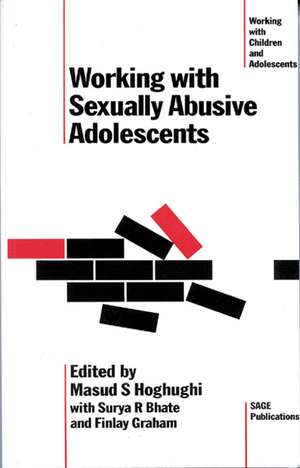Working with Sexually Abusive Adolescents: A Practice Manual: Working with Children and Adolescents series
Editat de Masud S Hoghughi, Suryakant R Bhate, Finlay Grahamen Limba Engleză Hardback – 9 oct 1997
Preț: 964.59 lei
Preț vechi: 1303.50 lei
-26% Nou
Puncte Express: 1447
Preț estimativ în valută:
184.58€ • 190.42$ • 154.03£
184.58€ • 190.42$ • 154.03£
Carte tipărită la comandă
Livrare economică 27 martie-10 aprilie
Preluare comenzi: 021 569.72.76
Specificații
ISBN-13: 9780803977587
ISBN-10: 0803977581
Pagini: 256
Dimensiuni: 138 x 216 x 25 mm
Greutate: 0.45 kg
Ediția:1
Editura: SAGE Publications
Colecția Sage Publications Ltd
Seria Working with Children and Adolescents series
Locul publicării:London, United Kingdom
ISBN-10: 0803977581
Pagini: 256
Dimensiuni: 138 x 216 x 25 mm
Greutate: 0.45 kg
Ediția:1
Editura: SAGE Publications
Colecția Sage Publications Ltd
Seria Working with Children and Adolescents series
Locul publicării:London, United Kingdom
Recenzii
`Adolescent sexuality is still substantially a tale of mystery and imagination. Certainly it does not figure highly in many clinical psychology training courses. This makes the appearance of this book all the more welcome. Masud Hoghughi and his colleagues should be congratulated for pulling together a range of material that will be of vital importance to any clinician considering working in this field.... this book represents the most contemporary British review of the field available, and as such will be an important resource for those starting out in this important area of work' - Clinical Psychology Forum
`There is much in this book that is of value' - Clinical Child Psychology and Psychiatry
`The book can be used both as an immediate and up-to-speed overview of adolescent sexual offending and also as a handbook for quick and easy reference, particularly in the area of treatment. This, for me, is the book's strength. Its versatility and easy-to-read style puts it in the same league as, for example, Bull and Carson's Handbook of Psychology in Legal Contexts. This text is a worthwhile read and I can thoroughly recommend it, particularly to colleagues working in the field' - Forensic Update
`This book constitutes a timely contribution to British literature on this topic area... The book should hold interest for social workers, youth justice staff, probation officers and others working with young sexual offenders' - British Journal of Social Work
`The editors have produced a key text that will stimulate further discussion and investigation in this important field of work' - Community Care
`There is much in this book that is of value' - Clinical Child Psychology and Psychiatry
`The book can be used both as an immediate and up-to-speed overview of adolescent sexual offending and also as a handbook for quick and easy reference, particularly in the area of treatment. This, for me, is the book's strength. Its versatility and easy-to-read style puts it in the same league as, for example, Bull and Carson's Handbook of Psychology in Legal Contexts. This text is a worthwhile read and I can thoroughly recommend it, particularly to colleagues working in the field' - Forensic Update
`This book constitutes a timely contribution to British literature on this topic area... The book should hold interest for social workers, youth justice staff, probation officers and others working with young sexual offenders' - British Journal of Social Work
`The editors have produced a key text that will stimulate further discussion and investigation in this important field of work' - Community Care
Cuprins
Sexual Abuse by Adolescents - Masud S Hoghughi
Theories of Adolescent Sexual Abuse - Masud S Hoghughi and Graeme Richardson
Managing Risk - Kevin J Epps
Assessment - Finlay Graham, Graeme Richardson and Surya R Bhate
Psychosocial Treatment - Adrian Needs
Educational Approaches to Treatment - John L Taylor
Cognitive-Based Practice with Sexually Abusive Adolescents - Graeme Richardson, Surya R Bhate and Finlay Graham
Behavioural Treatment Techniques - Dawn Fisher and Gail McGregor
Relapse Prevention - Graeme Richardson and Finlay Graham
Working in Context - Julie Hird
Professional Reports on Abusive Adolescents - Surya R Bhate and Masud S Hoghughi
Considering the Workers - Masud S Hoghughi
Theories of Adolescent Sexual Abuse - Masud S Hoghughi and Graeme Richardson
Managing Risk - Kevin J Epps
Assessment - Finlay Graham, Graeme Richardson and Surya R Bhate
Psychosocial Treatment - Adrian Needs
Educational Approaches to Treatment - John L Taylor
Cognitive-Based Practice with Sexually Abusive Adolescents - Graeme Richardson, Surya R Bhate and Finlay Graham
Behavioural Treatment Techniques - Dawn Fisher and Gail McGregor
Relapse Prevention - Graeme Richardson and Finlay Graham
Working in Context - Julie Hird
Professional Reports on Abusive Adolescents - Surya R Bhate and Masud S Hoghughi
Considering the Workers - Masud S Hoghughi
Descriere
`The editors have produced a key text that will stimulate further discussion and investigation in this important field of work' - Community Care
This book presents a clear and comprehensive overview of the key factors involved in working with adolescent sex offenders.
With an emphasis throughout on practical guidance, leading practitioners address a number of important questions: Who are sexually abusive adolescents and what do they do? What are the current theories of adolescent sexual abusiveness? How can we address issues of risk estimation and management? What are the assumptions behind many aspects of assessment and treatment?
This book presents a clear and comprehensive overview of the key factors involved in working with adolescent sex offenders.
With an emphasis throughout on practical guidance, leading practitioners address a number of important questions: Who are sexually abusive adolescents and what do they do? What are the current theories of adolescent sexual abusiveness? How can we address issues of risk estimation and management? What are the assumptions behind many aspects of assessment and treatment?

